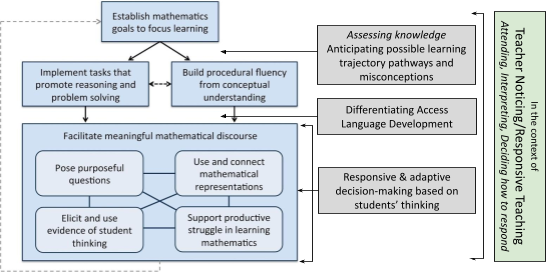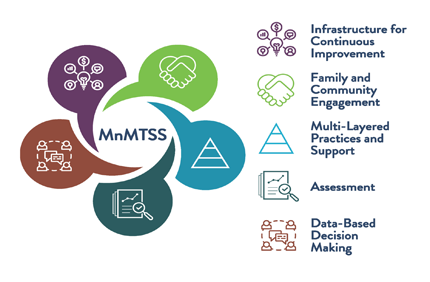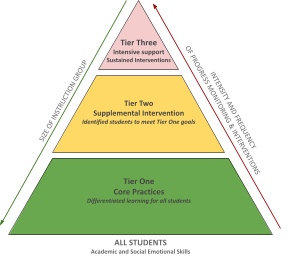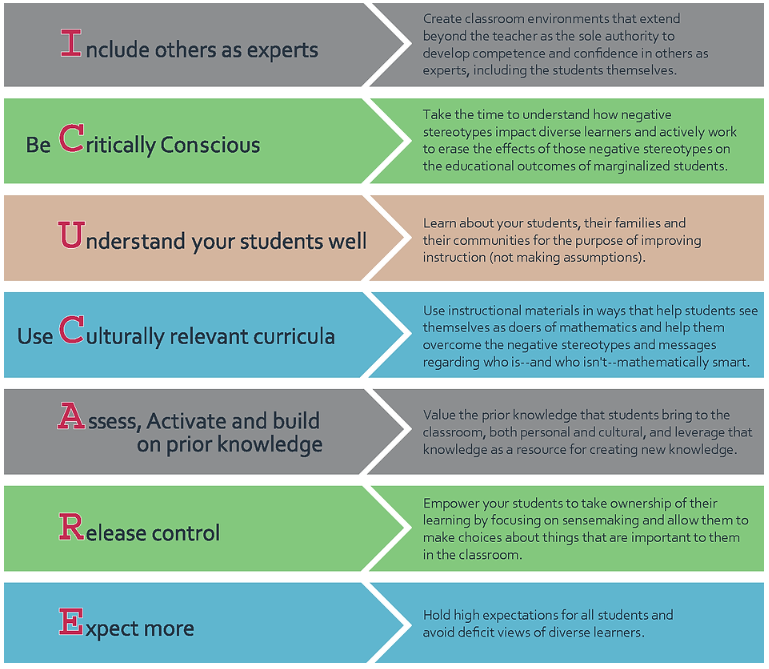Cluster Four: Instructional Practices – Differentiation (Access & equity)
Return to the Mathematical Practices Overview Page
A Professional Development Approach
- Access points for all students (MP1: Make sense of problems and persevere in solving them)
- Supportive interventions and extensions
- Develop student autonomy
- Plan with a vertical progression of the standards and benchmarks in mind
Introduction
Each classroom learning community has a range of students in terms of the strength of conceptual knowledge and procedural fluency. In a responsive classroom, differentiation arises from attending to the assets of those participants both in one’s planning and the in-the-moment opportunities as one decides how to respond. These decisions begin with interpreting the status of the whole classroom community in order to provide all students access to the mathematics. Differentiation is about the maximum growth and success of all students (Tomlinson & Allan, 2000). It is about supporting student autonomy, allowing for varied pacing, for editing one’s work, and allowance for multiple solution strategies. It includes the ways in which students are allowed to work and where to work within the learning space (Brickwedde, 2022). How and why to differentiate at the whole class level occurs in the planning process by reviewing what is already known about how one’s students think, where one would take students next, and what would students say and do that would constitute progression towards comprehending the mathematical objectives. Knowing where the range of students is, allows the instructional tasks to be refined and the access points to be identified. That being said, we need to be cognizant of student variability, recognizing that students’ needs will likely vary depending on the skill and concept.

Figure One: A System of Practice, System of Instruction (Hiebert, et al. 1997), Mathematics Teaching Framework (NCTM, Taking Action Series, 2017), Teacher Noticing Skills/Responsive Teaching (Jacobs, et al., 2010, Richards & Robertson, 2016)
Defining Differentiation
Differentiation in the mathematics classroom is about allowing and planning for multiple access points for students to engage in and to discuss the rich mathematical ideas under consideration. Elements within differentiation range from supporting student autonomy, to pacing, allowance for editing, and allowance for multiple solution strategies. It includes the ways in which students are allowed to work and where to work within the learning space. Differentiation is not a synonym for intervention nor ability grouping. Research has shown that ability grouping harms more than helps students. Instead, as teachers plan for Tier 1 learning, they plan for how all learners in the classroom will engage with the learning objective. That could mean flexible grouping based on recent formative data. (Brickwedde, 2022a; NCTM Position Statement: Differentiated Learning; Boaler 2005, Griesinger, 2023) The flexible grouping strategy is best used to form purposeful small groups of either 2 to 3 based on the task, language needs, and social dynamics of the class. This includes the use of public, randomly assigned groups (Liljedahl, 2021). Another model, called Mixed Strength Strong Groups, (Kobett and Karp, 2020) very strategically looks at student social skills brought to a group as much as the mathematical needs of the group’s members. Each of these models are most effective when used to strategically place emergent learners with more capable learners. It is important to ensure individual accountability as well as shared responsibility within groups. Create explicit guidelines, norms and roles for group members to ensure equal participation occurs. These flexible groups could last for an entire unit or for more shorter skill building tasks.
“A teacher who is differentiating, understands a student’s needs to express humor, or work with a group, or has additional teaching on a particular skill, or delve more deeply into a particular topic, or has guided help—and the teacher responds actively and positively to that need. The goal of a differentiated classroom is maximum student growth and individual success.” (Tomlinson and Allan, 2000)
Differentiation includes the use of tools/manipulatives and drawings to create physical and/or visual models in addition to tables, equations and graphs. It includes the possible variation of number range as entry points for different access points to the same mathematical standard. Comparing and contrasting differing solutions places the emphasis on the commonality of strategy. This allows learners to focus on key mathematical elements and structures that work across number ranges. Above all else, differentiated learning positions students to continue to grow vertically with mathematical ideas. Tricks and shortcuts are avoided as those hinder vertical progress.
Access Points for all Students
NCTM Position on Access and Equity: Creating, supporting, and sustaining a culture of access and equity requires being responsive to students' backgrounds, experiences, cultural perspectives, traditions, and knowledge when designing and implementing a mathematics program and assessing its effectiveness. Acknowledging and addressing factors that contribute to differential outcomes among groups of students are critical to ensuring that all students routinely have opportunities to experience high-quality mathematics instruction, learn challenging mathematics content, and receive the support necessary to be successful. Addressing equity and access includes both ensuring that all students attain mathematics proficiency and increasing the numbers of students from all racial, ethnic, linguistic, gender, and socioeconomic groups who attain the highest levels of mathematics achievement. (For full NCTM Position Statement: Access & Equity in Mathematics)
Reframing how we think about our students: The Persian poet Hafiz said, “The words we speak become the house we live in.” Much has been said about how we talk about our students. It is common to hear teachers talk about the low or bubble students in conversations with one another. The unintended consequence of this is that our words begin to influence the way we interact with our students and diminish their opportunities to engage in rigorous mathematics. Labels also tend to perpetuate negative ideas around math identity. NCTM Position Paper: Ability Labels
Allowance for Multiple Strategies: Particularly when new ideas are being explored by students, allowing students to choose their own strategy provides an essential access point to the mathematics. Students may successfully determine a solution but may need a drawn model or use manipulatives to derive it. Others may use charts and tables where yet others work purely at the number level. Interpreting those strategies becomes central to how as the teacher one may decide how to respond. Finding the commonalities and efficiencies across the representations becomes how students' ideas are molded and progress toward more formal levels of understanding over time. This is an example of differentiation; access through choice of strategy to comparing and contrasting ideas to move understanding to the next developmental level.
Multi-tiered Systems of Support (MTSS): The State of Minnesota, as part of meeting Federal requirements outlined in the Every Student Succeeds Act, (ESSA, 2015) supports schools in implementing the MTSS framework. MTSS is defined as “a comprehensive continuum of evidence-based, systemic practices to support a rapid response to students’ needs, with regular observation to facilitate data-based decision-making.” (MnMTSS, Minnesota Department of Education) (See Figure 2)
 |
 |
Figure Two: Left Image: Five Fundamental Components of MnMTSS, Minnesota Department of Education, Right Image: Multi-tiered Systems of Support
Tier One: Core Practices
Tier One (Primary instruction in the right hand image) takes place directly in the classroom. The teacher may be alone or be co-teaching with a colleague, e.g. ESL, instructional coach, etc. Tier One instruction includes culturally and linguistically sustaining standards-based and differentiated academic, social and emotional instruction for every student in the learning community as a necessary foundation for core instruction.
- Tier 1 practices include (p.25)
- Instructional practices that are culturally and linguistically sustaining, empowering, aligned to standards, and provide opportunities for student engagement, collaboration and discourse.
- Multiple data sources are used to differentiate instruction based on the needs and interests of students.
- Students are given opportunities to make connections between new information, their prior knowledge, and their lived experiences.
- Social-emotional learning is explicitly integrated with academic learning.
Asset-Based Instruction: Asset-based instruction focuses on student strengths and placing value on the diversity of experiences and thinking that students bring to the classroom. How do we authentically know our students and their strengths? In Choosing to See, Pamela Seda and Kyndall Brown (2022), describe the ICUCARE framework for building equity in the math classroom. (See Figure One.) Within this framework there are multiple strategies for leveraging student assets, such as “Two Minute Talks” where students turn and talk about the big idea of the day.

Figure One: ICUCARE Framework - Sela, P. and Brown, K. (2021) Choosing to see: A framework for equity in mathematics, Dave Burgess Consulting, Inc.
Take a look at the thoughts of researcher Beth McCord Kobett (2020) as she explains what it means to shift to a strengths-based teaching and learning approach.
Video Stop - Learn more about strengths-based teaching and learning
Access to grade level concepts is essential to close the opportunity gap and be can be enhanced by the inclusion of the following:
- Tools/manipulatives as supports for problem solving and communicating thinking
- Knowledge mobility to inspire new ideas and create peer experts
- Language clarity
- Rich Tasks that are engaging, relative, support productive struggle and require sustained thinking and reasoning
- Classroom culture that is conducive to risk taking, values mistakes, builds student agency, promotes curiosity of different perspectives and has high expectations for all
- Collaboration between teachers, students and their families
Additional Tier One Resources: Explore further planning for and enacting a Tier One classroom supporting student assets and providing access and equitable instructional practices that reaches the full range of students within the learning community.
Tier Two: Supplemental Intervention
Tier 2 supplemental supports are aligned to Tier 1 and are designed to assist identified students meet Tier 1 goals. Tier 2 interventions (p. 26) are an added layer of support, not a replacement of Tier 1 experiences. These supports may occur off to the side within the classroom supported by the classroom teacher or in another learning space by another teacher outside of the Tier One instructional timeframe.
Differentiation within Tier 2 will be important in order to make the intervention effective for each child. Refer to the list above for considerations to include in the Tier 2 experience.
Tier Three: Intensive Intervention
Tier 3 (intensive) interventions (p. 28) include culturally and linguistically sustaining individualized interventions provided to a few students and includes students with and without an Individualized Education Plan (IEP). Differentiation will continue to be necessary in Tier 3, as well. Again, the list in the preceding section supports learning in this setting. This intensive instruction typically is conducted by specialized teachers such as special education and English as a Second Language (ESL) teachers, or, for example, Math Recovery Intervention Specialists.
The U.S. Department of Education’s What Work Clearinghouse posts the following summary of research in Assisting Students Struggling with Mathematics: Intervention in the Elementary Grades (2021). Practice Guide 26 makes six recommendations for small-group and one-on-one intervention instructional settings in grades K-6.
- Systematic Instruction: Provide systematic instruction during intervention to develop student understanding of mathematical ideas (Practice Guide 26, pp. 5-10)
- Review and integrate previously learned content throughout intervention to ensure that students maintain understanding of concepts and procedures
- When introducing new concepts and procedures, use accessible numbers to support learning
- Sequence instruction so that the mathematics students are learning builds incrementally
- Provide visual and verbal supports
- Provide immediate, supportive feedback to students to address any misunderstandings.
- Mathematical Language: Teach clear and concise mathematical language and support students’ use of the language to help students effectively communicate their understanding of mathematical concepts. (Practice Guide 26, pp. 11-20).
- Representations: Use a well-chosen set of concrete and semi-concrete representations to support students’ learning of mathematical concepts and procedures. (Practice Guide 26, pp. 21-28).
- Number Lines: Use the number line to facilitate the learning of mathematical concepts and procedures, build understanding of grade-level material, and prepare students for advanced mathematics. (Practice Guide 26, pp. 29-39).
- Word Problems: Provide deliberate instruction on word problems to deepen students’ mathematical understanding and support their capacity to apply mathematical ideas. (Practice Guide 26, pp. 40-50). This does not imply the teaching of "keywords" and merely circling numbers. Comprehension of the action or structure of the text, inclusive of the units attached to any quantity, is to be stressed.
- Timed Activities: Regularly include timed activities as one way to build fluency in mathematics. (Practice Guide 26, pp. 51-55).
- This recommendation should be considered sensitively as many people have experienced various degrees of math trauma associated with timed activities associated with speed. John Van de Walle (2016) shared that if students participate in these activities when they are direct modelers or counters, they simply become fast counters. Rather, if the teacher is compelled to use timed activities, they should have carefully selected tasks that relate directly to the non-count-by-ones strategies the child has been developing but is not fluent with…yet.
- The National Council of Teachers of Mathematics (NCTM) has taken a different stand on this topic. There is agreement that procedural fluency is a valuable component of developing mathematical competence. NCTM has identified the following declarations regarding procedural fluency:
-
Conceptual understanding must precede and coincide with instruction on procedures
-
Procedural fluency requires having a repertoire of strategies
-
Basic facts (single-digit combinations) should be taught using number relationships and reasoning strategies, not memorization.
-
Assessing must attend to fluency components and the learner. Assessments often assess accuracy, neglecting efficiency and flexibility. Timed tests do not assess fluency and can negatively affect students, and thus should be avoided (Boaler, 2014; Kling and Bay-Williams, 2021; NCTM, 2020; Ramirez, Shae, and Maloney, 2018). Alternatives include interviews, observations, and written prompts.
-
- Additional resources on developing fluid recall of the single-digit combinations/basic facts
Extensions
Each and every student should have the opportunity to be enriched. It is not about adjusting the workload or grading differently. Assigning open-ended, rich inquiry activities that promote critical thinking, generate new knowledge and provide experiences allows for students to critique and revise their arguments.
NCTM Position on enrichment opportunities::
- Students with exceptional mathematical promise must be engaged in enriching learning opportunities during and outside the school day to allow them to pursue their interests, develop their talent, and maintain their passion for mathematics. Such opportunities must be open to a wide range of students who express a higher degree of interest in mathematics, not just to those who are identified through traditional assessment instruments.
Developing Student Autonomy
“When students are not given freedom of choice or taught critical thinking skills, they are less likely to develop the tools they need to fulfill their career aspirations later in life - that it is in the professions or the trades or some other path of their choosing.” (Novak, K., 2022 p. 67)
- Create options and choices for students.
- Number choices
- Mode of work (alone, partner, small group)
- Supporting materials (manipulatives, sketches)
- Set the bar high, with scaffolds and various levels of challenge, provide options to reach it through:
- Work exemplars
- Rubrics
- Graphic organizers
- Provide specific and mastery-oriented feedback and support based on outcomes of formative assessments.
Planning
To achieve differentiation (NCTM Position Statement: Differentiated Learning) both the choice of mathematical tasks to learn the standard for the day and the nature of the student discourse with peers need to be planned in advance of the lesson.
“Learning from a grade-level-appropriate curriculum is not a privilege. It's a right for all students. Whether they seem prepared is irrelevant. It's our job as teachers to fill in the gaps for students so they can have a challenging course of study with academic rigor.” (Novak, K., 2022. p. 114)
Presume competence in order to provide every student a rigorous, standards-based instruction.
- Determine if the standard(s) require students to learn a concept or perform a skill.
- Provide students options to express their learning (autonomy)
- Design scaffolding which embodies four key features (Novak, K., 2022. p. 118-128):
- Active engagement - engagement of not only students, teachers need to be engaged in planning and delivering lessons while providing meaningful feedback
- Intersubjectivity - involves the relationships between teacher and students (knowing who the students are)
- Ongoing diagnosis - provide meaningful feedback to support students deepening their understanding
- Transfer of responsibility - gradual release of students
- Use parallel and open-ended tasks (Seda & Kyndall, 2023, pp. 170-171)
- Parallel tasks - two or more tasks that allow students at a variety of levels to engage with the big ideas of the lesson
- Open ended tasks - instead of solving for 23 + 17. Ask students to create questions where the answer is 40.
- Avoid the “Matthew Effect” where the most successful students are continually provided with activities that further their success, while emergent students are deprived of rich learning experiences.
Differentiation is about providing access to the mathematical content through multiple entry points and the ability to use a variety of strategies for ALL students in the learning environment. Differentiation is not about ability grouping. Research has shown that ability grouping harms more than helps students. Instead, as teachers plan for Tier 1 learning, they plan for how all learners in the classroom will engage in the curriculum. That could mean flexible grouping based on recent formative data. Universal Design for Learning is one principled approach.
Return to the Mathematical Practices Overview Page
References
Brickwedde, J. (2022a) Instruction practices: Differentiation. Project for Elementary Mathematics. Retrieved from: https://stemtc.scimathmn.org/sites/default/files/Differentiation_Brickwedde-2022.pdf
Brickwedde, J. (2022b) Learning Single-digit Combinations: Developing Important Mathematical Ideas, Part IV: An Implementation Policy, Project for Elementary Mathematics. Retrieved from: https://stemtc.scimathmn.org/sites/default/files/Learning%20Single-Digit%20Combinations_Brickwedde-2022r.pdf
Mellard, D.F., (2009) CEC’s RTI Blog. Retrieved at: https://cecblog.typepad.com/rti/2009/01/levels-of-interventions.html#more
Every Student Succeeds Act, 20 U.S.C. § 6301 (2015). https://www.congress.gov/bill/114th-congress/senate-bill/1177
Fuchs L. S., Bucka N., Clarke B., Dougherty B., Jordan N. C., Karp K. S., Woodward J. (2021). Assisting students struggling with mathematics: Intervention in the elementary grades. U.S. Department of Education, Institute of Education Sciences. Retrieved from: https://ies.ed.gov/ncee/wwc/PracticeGuide/26
Heibert, J., Carpenter, T.P., Fennema, E., Fuson, K. C., Wearne, D., Murray, H. Olivier, A., and Human, P. (1997). Making sense: Teaching and learning mathematics with understanding. pp. 29-41. Portsmouth, NH.: Heinemann Press.
Jacobs, V.R., Lamb, L.L.C., Phillipps, R.A. (2010) Professional Noticing of Children’s Mathematical Thinking. Journal for Research in Mathematics Education. 41(2), 169–202.
Kobett, B.M. & Karp, K.S. (2020). Strength-based Teaching and Learning in Mathematics: Five Teaching Turnarounds for Grades K-6. Thousand Oaks, CA: Corwin.
Liljedahl, P. (2021). What is building thinking classrooms: An executive summary of 15 years of research. Retrieved from: https://buildingthinkingclassrooms.com/wp-content/uploads/2020/11/Executive-Summary.pdf
National Council of Teachers of Mathematics. Differentiated Learning. Retrieved from: https://www.nctm.org/conferences-and-Professional-Development/Tips-for-Teachers/Differentiated-Learning/
National Council of Teachers of Mathematics (2017). Taking action: Implementing Effective Mathematics Teaching Practices. https://www.nctm.org/store/takingaction/. Reston, VA.: NCTM.
Novak, K. (2022) UDL Now!: A Teacher’s Guide to Applying Universal Design for Learning. Lynnfield, MA: Cast Publishing.
Richards, J. and Richardson, A.D., (2015). A Review of the Research on Responsive Teaching. In A. D. Robertson, R. E. Scherr, and D. Hammer (Eds.) Science and Mathematics Responsive Teaching in Science and Mathematics (pp.36-55). London: Cast Publishing.
Seda, P. and Brown, K. (2021). Choosing to see: A framework for equity in the math classroom. San Diego, CA: Dave Burgess Consulting, Inc.
Tomlinson, C.A. & Allan, S.D. (2000). Leadership for Differentiating Schools and Classrooms. Cheltenham, Australia: Hawker Brownlow Education.
Van de Walle, J.A, Karp, K.S., & Bay-Williams, J.M. (2016). Planning in the problem based classroom, In Elementary and Middle School Mathematics: Teaching Developmentally, Ninth Edition, pp. 57-83. London: Pearson.
Van de Walle, J.A, Karp, K.S., & Bay-Williams, J.M. (2016). Developing basic fact fluency, In Elementary and Middle School Mathematics: Teaching Developmentally, Ninth Edition, pp. 194-221. London: Pearson.
Search for a Framework
Search the Mathematics and Science Frameworks.
Begin your Search »
Feedback
We want your feedback! Tell us what's working, what's not, and how you are using these Frameworks.
Give us your Feedback »
